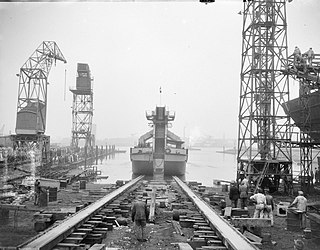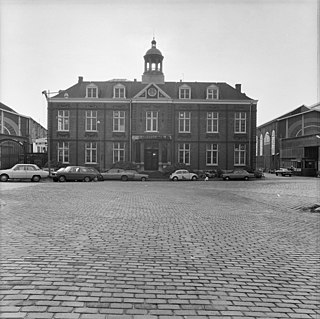
Vigor Shipyards is the current entity operating the former Todd Shipyards after its acquisition in 2011. Todd Shipyards was founded in 1916, which owned and operated shipyards on the West Coast of the United States, East Coast of the United States and the Gulf. Todd Shipyards were a major part of the Emergency Shipbuilding Program for World War II.

SBM Offshore N.V. is a Dutch-based global group of companies selling systems and services to the offshore oil and gas industry. Its constituent companies started their offshore activities in the early 1950s and SBM subsequently became a pioneer in single buoy moorings (SBM) systems. The firm leases and operates Floating Production Storage and Offloading vessels, and is involved in the design and engineering, construction, installation, operation and maintenance of floating production equipment for the offshore Oils and Gas industry. It is a main board listed company on the Euronext Amsterdam stock exchange and has been a member of the AEX index since 2003. It has been engulfed by a massive corruption scandal in Brazil.

The Rotterdamsche Droogdok Maatschappij (RDM) was the largest pre-World War II shipbuilding and repair company in Rotterdam in the Netherlands, existing from 1902 to 1996. It built 355 mostly major seagoing vessels, 18 of which were submarines. During its existence, the wharf operated 12 floating docks and in its heyday employed 7,000 people at one time.

Wilton-Fijenoord was a shipbuilding and repair company in Schiedam, Netherlands from 1929 to 1999. Presently, the shipyard of Wilton-Feijnoord is part of Damen Shiprepair Rotterdam.
NDSM is a neighborhood in Amsterdam, Netherlands located on the former terrain of the Nederlandsche Dok en Scheepsbouw Maatschappij (NDSM) shipbuilding company. It is located in the Amsterdam-Noord borough along the IJ river and can be reached by ferry from Amsterdam Centraal station. After the shipyard closed, the various buildings were occupied by squatters before being gentrified in the 2000s, becoming offices for groups such as Greenpeace, MTV, Pernod Ricard, Red Bull and ViacomCBS. The East part of the former wharf houses a large number of art galleries and festivals throughout the year. The IJhallen is the biggest flea market in Europe, it also houses various populair restaurants Pllek, IJver, Loetje aan het IJ, Noorderlicht, Next. NDSM-West is redeveloped as a mixed-use residential area with high-rise buildings up to 120 meters. By 2034 NDSM-West will have 5000 residential units. NDSM-Oost will be redeveloped into a city park with art galleries and the monumental buildings.

Sanoyas Hishino Meisho Corporation is a Japanese company that consists of four principal business groups and twelve affiliated companies. The business groups are: the Ship and Steel Structure Group, the Parking System & Engineering Group, the Construction Machines Group, and the Leisure Business Group.

The Viktor Lenac Shipyard is situated on the northern Croatian Adriatic coast, 3 km from the largest Croatian port It was founded in 1896, and was among the first in the world to deal with ship lengthenings. It is quoted on the Zagreb Stock Exchange with ticker VLEN-R-B.

The shipbuilding company Rijn-Schelde-Verolme Machinefabrieken en Scheepswerven NV (RSV) was a combination of shipbuilding companies and machine factories founded in 1971. In 1983 the company went broke with a staggering loss of public money. It led to the Parliamentary inquiry about RSV.

Van Vlissingen en Dudok van Heel was a famous nineteenth-century Dutch machine factory. It built steam engines and machinery for the sugar industry and for maritime purposes, as well ships, rolling stock and large metal structures like the Moerdijk bridge and a floating dock. In 1871 it was reorganized to become the public company Koninklijke Fabriek van Stoom- en andere Werktuigen. In a second reorganization in 1890, parts of it were saved and continued under the name Koninklijke Nederlandsche Fabriek van Werktuigen en Spoorwegmaterieel, renamed to Werkspoor in 1927.

Wilton's Dok- en Werf Maatschappij was a Dutch shipbuilding company active as an independent company from 1854 till 1929. At first it was simply known as 'Wilton'. In 1921 the final Dutch name became: 'Wilton's Dok- en Werf Maatschappij NV', the equivalent of 'Wilton Engineering and Slipway Company'. Wilton started as a traditional smithy and expanded in machinery. It specialized in ship repairs, but also became a shipyard. At first only for fresh water ships. In spite of multiple name changes the company was commonly referred to as 'Wilton'. In 1929 a merger with Fijenoord led to a new company known as Wilton-Fijenoord.

The Nederlandsche Scheepsbouw Maatschappij, was a Dutch shipbuilding company based in Amsterdam. It existed from 1894 to 1946. From c. 1908 it was the biggest Dutch shipbuilding company.

Onrust Dock of 3,000 tons, was a floating dry dock that served in the Dutch East Indies from 1869 till at least 1933. Up till about 1910 she was a crucial part of the Dutch naval infrastructure in the Indies.

Volharding Dock, was a floating dry dock built for the Nederlands Indische Droogdok Maatschappij (NIDM) in the 1870s. It was the smallest of two unique tower dry docks, and the only one that would actually be put in use.

Amsterdam Wooden Drydock I was the first floating dry dock of Amsterdam, and probably the first modern floating dry dock of Europe.

Amsterdamsche Droogdok Maatschappij (ADM) was a Dutch company that repaired ships using dry docks in Amsterdam, Netherlands. After World War II it also built some ships.

J. & K. Smit was a Dutch shipbuilding company located in Kinderdijk and Krimpen aan de Lek. Its successor is now part of Royal IHC.

Royal IHC or Koninklijke IHC, previously IHC Holland (1943–1995), IHC Holland Merwede (1995–2005) and IHC Merwede (2005–2014) is a Dutch shipbuilding company with headquarters in Kinderdijk. It focuses on the development, design and construction of ships for the dredging and offshore industries.

Gusto Shipyard, previously A.F. Smulders, was a shipbuilding company in Schiedam, Netherlands. It was famous for dredging and offshore vessels. In 1978 it was closed down under suspicious circumstances. Its engineering office still exists as GustoMSC, a subsidiary of American oil rig and equipment manufacturer NOV Inc.

L. Smit en Zoon previously known as Fop Smit, was a Dutch shipbuilding company located in Kinderdijk. Its successor is now part of Royal IHC.

Droogdok Maatschappij Soerabaja (DMS) was a Dutch shipbuilding and repair company which had a shipyard in the Dutch East Indies.



















